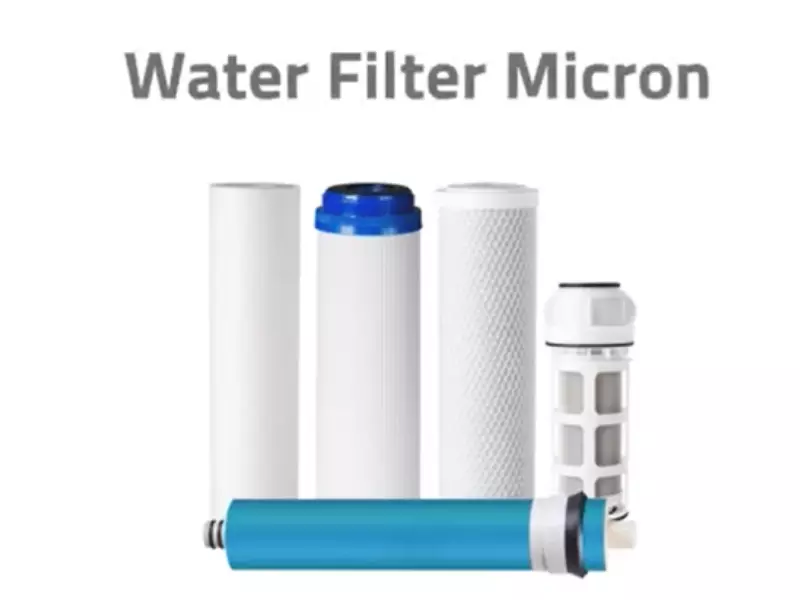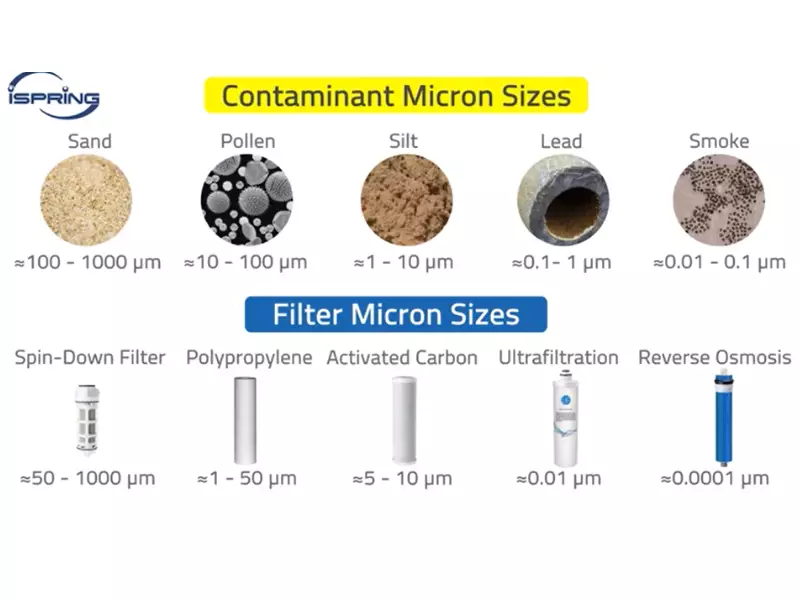Well water, though a common and natural source of drinking water, comes with its own challenges. From microscopic contaminants to visible sediments, the need for effective filtration is paramount. The key to ensuring clean, safe drinking water is selecting the right filter size, measured in microns.
The best filter size for well water typically ranges between 1 to 100 microns. This range effectively tackles most contaminants, ensuring water clarity and safety.
Micron size in filters plays a pivotal role in determining the purity and clarity of well water. Its selection becomes even more crucial for households that rely solely on well water for their daily needs.
Micron Size Explained
In the realm of water filtration, understanding the term ‘micron’ is paramount. A micron, scientifically termed a micrometer (µm), represents one-millionth of a meter. Grasping this unit’s minuteness is crucial for making informed decisions about well water filtration.

The Significance of Micron in Filtration
Microns provide a measure of the pore size in filters, essentially determining what gets filtered out and what slips through. For context:
- Human Hair: A strand of human hair, which can be seen easily with the naked eye, is about 70 microns in diameter.
- Pollen: A common allergen that troubles many, typically measures between 10 to 100 microns.
- Bacteria: These microscopic entities range from 0.2 to 2 microns.
Thus, when you select a filter rated for a certain micron size, you’re essentially ensuring that particles of that size (and larger) are being captured, while smaller particles might pass through.
Micron Size in Perspective
To appreciate the intricacies of water filtration, let’s relate micron sizes to everyday objects:
- Grains of Sand: Sand particles, often visible in turbid water, measure between 100 to 2000 microns.
- Red Blood Cells: These vital cells span approximately 5 to 10 microns.
- Bacteria: Potentially harmful when present in drinking water, they’re often between 0.2 to 10 microns.
Types of Contaminants in Well Water
Water sourced from wells isn’t just H2O; it often contains a mix of contaminants ranging from harmless to potentially dangerous.
Visible Contaminants
- Sand and Sediment: These can cloud water, affecting its taste and appearance. Over time, they can also wear down plumbing fixtures and reduce the efficiency of water-using appliances.
- Silt: Finer than sand but still a common concern, silt can give water a murky appearance.
Microbial Threats
- Bacteria: From E.coli to legionella, certain bacteria strains can pose significant health risks.
- Viruses: Smaller than bacteria, viruses like norovirus and rotavirus can slip through larger filters.
- Protozoa: Organisms like giardia and cryptosporidium can cause gastrointestinal issues when ingested.
Chemical and Mineral Contaminants
- Organic Compounds: These include herbicides, pesticides, and other chemicals which might leach into groundwater.
- Heavy Metals: Arsenic, lead, and mercury are just a few examples that can be harmful in significant amounts.
- Hard Water Minerals: Calcium and magnesium, while not harmful, can create scale buildup in pipes and appliances.
Filter Types and Micron Size
A plethora of filters cater to the varied challenges posed by well water contaminants. Each type has its specific purpose and efficiency based on its micron rating.
Sediment Filters
These act as the primary defense against larger particulates:
- Role: Capturing visible contaminants like sand and silt.
- Common Sizes: Typically range from 30 to 50 microns, but finer versions exist for more turbid water sources.
Carbon Filters
Activated carbon filters serve a dual purpose:
- Contaminant Removal: Effective against organic compounds, chlorine, and certain chemicals, they improve taste and odor.
- Micron Ratings: These filters often range from 0.5 to 50 microns. The finer the rating, the more effective they are against microbial threats.
Ceramic Filters
Ceramics have been used for centuries in water purification:
- Functionality: Their microscopic pores trap contaminants, ensuring water passing through is clean.
- Efficiency: Best suited for the 0.5 to 1-micron range, they’re efficient against many bacteria and protozoa.

Choosing the Right Size for Well Water
Selecting an appropriate filter micron size for well water is no arbitrary decision. It’s pivotal for ensuring the water’s healthiness, taste, and clarity. Here’s how you can make the right choice:
Assessing Well Water Quality: Preliminary Tests
Before any purchase, test your well water to determine the present contaminants:
- Professional Testing: Consider hiring a service for a comprehensive analysis. They can detect a range of pollutants, from bacteria to heavy metals.
- DIY Kits: These are available at most hardware stores and can give a basic understanding of your water’s quality.
Factors Influencing Micron Size Choice
Several factors play into determining the optimal micron size:
- Contaminant Type and Concentration: If your water contains harmful microbes, opt for a finer filter. High sediment levels may require a pre-filter to manage larger particles.
- Household Consumption and Usage Pattern: Larger families or homes with high water usage might prefer filters that don’t reduce flow rate significantly.
- Desired Water Clarity and Taste: For crystal clear water with minimal taste, a finer filtration system is ideal.
General Guidelines on Size Selection
- For Sediment-Heavy Water: Start with a 30 to 50-micron sediment pre-filter, followed by finer stages.
- Microbial Concerns: Choose filters below 1 micron. A 0.2-micron filter can handle most bacteria and protozoa.
Pros and Cons of Various Micron Sizes
Every micron size has its advantages and challenges. Knowing these can help in making a balanced decision.
Advantages of Finer Filtration
- Better Clarity: Finer filters, especially those under 1 micron, can produce pristine water, free of visible contaminants.
- Microbial Removal: Filters rated below 0.5 microns are effective against many harmful bacteria and protozoa.
Drawbacks of Too Fine Filtration
- Reduced Flow Rate: Extremely fine filters can reduce water pressure, which might not be suitable for households with high water demand.
- Frequent Filter Changes: As they trap more particles, they can clog quicker, requiring more regular replacements.
Real-world Scenarios
Case Studies Illustrating Micron Size Choice Based on Unique Well Water Conditions
- Farmhouse Well with Pesticide Runoff: In a scenario where a well is near agricultural lands, a carbon filter of 5 microns was used. It effectively reduced organic compounds and improved water taste.
- Mountain Retreat with Clear Spring Source: Here, a 10-micron filter sufficed, ensuring great-tasting water without any visible impurities.
Maintenance and Filter Change
Routine maintenance and timely filter replacements ensure consistent water quality.
Importance of Timely Replacement
- Efficiency: Over time, a clogged filter loses its effectiveness, possibly allowing contaminants to pass.
- Prevent Microbial Growth: Used filters can become breeding grounds for microbes.
Signs Indicating a Filter Change is Required
- Reduced Flow Rate: A noticeable drop in water pressure often signifies a clogged filter.
- Altered Taste or Odor: If water starts tasting odd or develops a smell, the filter might be saturated.
Tips for Prolonging Filter Lifespan
- Regular Backwashing: Some filters allow backwashing, which can remove accumulated particles.
- Pre-filters: Using a sediment pre-filter can prolong the life of finer filters downstream.
Frequently Asked Questions
Why is the right micron size crucial for well water?
The correct micron size ensures the removal of specific contaminants, improving water safety and clarity.
Can I use multiple filters of different micron sizes?
Yes, using a multi-stage filtration system allows the removal of contaminants of various sizes more effectively.
How often should I replace my well water filter?
Typically, every 3-6 months, but this can vary based on water quality and household consumption.
Conclusion
Selecting the correct micron size for well water filtration is a balance between clarity, safety, and maintenance. A comprehensive understanding of contaminants and household needs can guide an informed choice, ensuring clean, safe drinking water for all residents.
Remember, well water’s purity is not just about clarity but also about safeguarding health by removing harmful contaminants.
The journey towards pristine well water begins with the right filtration choices. Ensure regular maintenance and timely filter changes to enjoy the pure essence of nature in every sip.